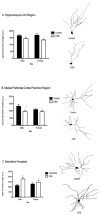Stress and the developing adolescent brain
- PMID: 23123920
- PMCID: PMC3601560
- DOI: 10.1016/j.neuroscience.2012.10.048
Stress and the developing adolescent brain
Abstract
Adolescence is a time of continued brain maturation, particularly in limbic and cortical regions, which undoubtedly plays a role in the physiological and emotional changes coincident with adolescence. An emerging line of research has indicated that stressors experienced during this crucial developmental stage may affect the trajectory of this neural maturation and contribute to the increase in psychological morbidities, such as anxiety and depression, often observed during adolescence. In this review, we discuss the short- and long-term effects of periadolescent stress exposure on the structure and function of the brain. More specifically, we examine how stress at prepubertal and early adolescent stages of development affects the morphological plasticity of limbic and cortical brain regions, as well as the enduring effects of adolescent stress exposure on these brain regions in adulthood. We suggest that, due to a number of converging factors during this period of maturation, the adolescent brain may be particularly sensitive to stress-induced neurobehavioral dysfunctions with important consequences on an individual's immediate and long-term health and well-being.
Keywords: ACTH; CA1; CMS; CRS; CVS; DG; GR; HPA; HPA axis; LR; MPN; MR; N-methyl-D-aspartate; NMDA; OFC; SEM; SP-MF; TSST-C; Trier Social Stress Test for Children; adolescence; adrenocorticotropin hormone; chronic mild stress; chronic restraint stress; chronic variable stress; cornu ammonis 1; dentate gyrus; glucocorticoid receptor; hypothalamic–pituitary–adrenal; low responder; mPFC; medial prefrontal cortex; medial preoptic nucleus; mineralocorticoid receptor; orbitofrontal cortex; puberty; standard error of the mean; stress; supra-pyramidal mossy fiber terminal fields.
Copyright © 2012 IBRO. Published by Elsevier Ltd. All rights reserved.
Figures



References
-
- Andersen SL. Trajectories of brain development: point of vulnerability or window of opportunity. Neurosci Biobehav Rev. 2003;27:3–18. - PubMed
-
- Andersen SL, Teicher MH. Delayed effects of early stress on hippocampal development. Neuropsychopharmacology. 2004;29:1988–1993. - PubMed
-
- Barha CK, Brummelte S, Lieblich SE, Galea LAM. Chronic restraint stress in adolescence differentially influences hypothalamic-pituitary-adrenal axis function and adult hippocampal neurogenesis in male and female rats. Hippocampus. 2011;21:1216–1227. - PubMed
-
- Bell HC, Pellis SM, Kolb B. Juvenile peer play experience and the development of the orbitofrontal and medial prefrontal cortex. Behav Brain Res. 2010;207:7–13. - PubMed
Publication types
MeSH terms
Substances
Grants and funding
LinkOut - more resources
Full Text Sources
Other Literature Sources
Medical
Miscellaneous

